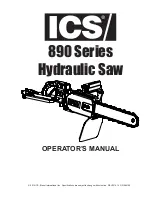
Fig. 25: upper blade guides
Fig. 26: lower blade guides
The thrust bearing (D) is mounted on a concentric shaft
(C). When the shaft is rotated, the relative position of the
bearing to the back of the blade can be changed.
Rotate the adjustment shaft (C) so the thrust bearing (D)
just clears the back of the saw blade.
Tighten thumbscrew/setscrew (A).
NOTE: If a blade is being replaced with a new one of a
different size, the adjustment described above may fall
out of range and further adjustment may be required as
follows:
Loosen the socket head screw (E, not visible) with a
10mm wrench and adjust the entire assembly back or
forth to just clear the back of the saw blade. Tighten
screw (E), then fine tune the adjustment by repeating the
first part of this step.
Secure the thrust bearing (D) by tightening the
thumbscrew (A, upper guide) or setscrew (A, lower
guide).
Guide bearing adjustment
Refer to Figures 25 and 26:
Note: Blade must already be tensioned and track-ing
properly .
Disconnect machine from power source.
For upper blade guide, loosen two thumb-screws (F). For
lower blade guide, loosen two setscrews (F) with the
3mm hex wrench provided.
Slide adjustment shaft (G) to position each guide bearing
(H) approximately 1/16" behind the gullets of the saw
blade.
The guide bearing (H) is mounted on a concentric shaft.
When the shaft (G) is rotated, the relative position of the
guide to the blade can be changed.
Rotate each adjustment shaft (G) to position the guide
bearings (H) within 1/32" of the saw blade.
Secure the guide bearings (H) by tightening
thumbscrews (F, upper guide) or setscrews (F, lower
guide).
Fig.27
7.6 Miter gauge adjustment
Refer to Figure 28:
To adjust angle of miter gauge, loosen handle (J) and
rotate gauge body. Tighten handle.
Place miter gauge into table slot and use a square to
verify that 90-degree setting on scale is 90-degrees to
slot. Adjust pointer (K) if necessary.
Fig. 28



































